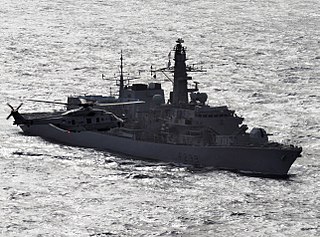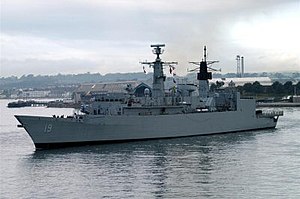
HMS Ocean was a Landing Platform Helicopter, formerly the UK's helicopter carrier and the fleet flagship of the Royal Navy. She was designed to support amphibious landing operations and to support the staff of Commander UK Amphibious Force and Commander UK Landing Force. She was constructed in the mid-1990s by Kvaerner Govan on the River Clyde and fitted out by VSEL at Barrow-in-Furness prior to trials and subsequent acceptance in service. Ocean was commissioned in September 1998 at her home port HMNB Devonport, Plymouth.

HMS Illustrious was a light aircraft carrier of the Royal Navy and the second of three Invincible-class ships constructed in the late 1970s and early 1980s. She was the fifth warship and second aircraft carrier to bear the name Illustrious, and was affectionately known to her crew as "Lusty". In 1982, the conflict in the Falklands necessitated that Illustrious be completed and rushed south to join her sister ship HMS Invincible and the veteran carrier HMS Hermes. To this end, she was brought forward by three months for completion at Swan Hunter Shipyard, then commissioned on 20 June 1982 at sea en route to Portsmouth Dockyard to take on board extra stores and crew. She arrived in the Falklands to relieve Invincible on 28 August 1982 in a steam past. Returning to the United Kingdom, she was not formally commissioned into the fleet until 20 March 1983. After her South Atlantic deployment, she was deployed on Operation Southern Watch in Iraq, then Operation Deny Flight in Bosnia during the 1990s and Operation Palliser in Sierra Leone in 2000. An extensive re-fit during 2002 prevented her from involvement in the 2003 Iraq War, but she was returned to service in time to assist British citizens trapped by the 2006 Lebanon War.

HMS Albion is a landing platform dock of the Royal Navy, the first of the two-ship Albion class. Built by BAE Systems Marine in Barrow-in-Furness, Albion was launched in March 2001 by the Princess Royal. Her sister ship, Bulwark, was launched in November 2001, also from Barrow. Affiliated to the city of Chester and based in Plymouth, she is the ninth ship to carry the name Albion, stretching back to the 74-gun 1763 warship, and last carried by an aircraft carrier decommissioned in 1973 after 19 years service. Designed as an amphibious warfare ship, Albion carries troops, normally Royal Marines, and vehicles up to the size of the Challenger 2 main battle tank. She can deploy these forces using four Landing Craft Utility (LCUs) and four Landing Craft Vehicle and Personnel (LCVPs). A flight deck supports helicopter operations.

HMS Norfolk was a British Type 23 frigate, the sixth in the Royal Navy to use this name, laid down in 1985 by Yarrow Shipbuilders. She was launched on the Clyde by Princess Margaret, Countess of Snowdon in July 1987 and named for the Dukedom of Norfolk. She was commissioned on 1 June 1990. Norfolk was the 'first of class', as well as being the first of a new generation of 'lean manned' ships. She was commissioned into the Chilean Navy in 2006 as Almirante Cochrane.

HMS Montrose was the eighth of the sixteen-ship Type 23 or Duke class of frigates, of the Royal Navy, named after the Duke of Montrose. She was laid down in November 1989 by Yarrow Shipbuilders on the Clyde, and was launched on 31 July 1992 by Edith Rifkind, wife of Malcolm Rifkind, Secretary of State for Defence. She was commissioned into service in June 1994.

The third and current HMS Argyll is a Type 23 Duke-class frigate. She is currently the oldest serving Type 23 frigate in the Royal Navy. Like all of her class she is named after a British dukedom, in this case that of Argyll. HMS Argyll was laid down in March 1987 by Yarrow Shipbuilders at Glasgow, and launched in 1989 by Lady Wendy Levene, sponsored by the Worshipful Company of Paviors. She was commissioned in May 1991. Argyll is currently based at HMNB Devonport.

Almirante Condell is a Duke-class Type 23 frigate in service with the Chilean Navy. It entered service with the Royal Navy in 1991 with the name HMS Marlborough as the sixth ship to bear the name. She was named after John Churchill, 1st Duke of Marlborough, and served in the Middle East. The frigate was taken out of service in 2005 and sold to Chile. The vessel entered service with the Chilean Navy in 2008 and was renamed Almirante Condell after Carlos Condell, a Chilean naval officer during the War of the Pacific. The ship was significantly upgraded from 2020 to 2021 and remains in service.

HMS Monmouth was the sixth "Duke"-class Type 23 frigate of the Royal Navy. She was the seventh ship to bear the name and was launched by Lady Eaton in 1991, being commissioned two years later.

HMS Richmond is a Type 23 frigate of the Royal Navy. She was launched on 6 April 1993 by Lady Hill-Norton, wife of the late Admiral of the Fleet The Lord Hill-Norton, and was the last warship to be built by Swan Hunter Shipbuilders. She sailed from the builders on the River Tyne in November 1994. She is named for the Dukedom of Richmond.

HMS Grafton is a Type 23 frigate formerly in service with the Royal Navy. She was the ninth vessel to bear the name, and is named after the Duke of Grafton. Ordered in January 1992, Grafton was laid down on 13 May 1993 by Yarrow Shipbuilders. The frigate was launched on 5 November 1994 and commissioned into the Royal Navy on 29 May 1997 with the pennant number F80. In 2007 the ship was transferred to Chile as Almirante Lynch and, having undergone a significant upgrade from 2019 to 2020, remains in service with the Chilean Navy.

RFA Fort Rosalie was the lead ship of her class of Royal Fleet Auxiliary fleet replenishment ships. Fort Rosalie was originally named RFA Fort Grange, but was renamed in May 2000 to avoid confusion with the now-decommissioned RFA Fort George. On 31 March 2021, the ship was withdrawn from service.

HMS Bulwark is the second ship of the Royal Navy's Albion-class assault ships. She is one of the United Kingdom's two landing platform docks designed to put Royal Marines ashore by air and by sea.

HMS Antrim was a County-class destroyer of the British Royal Navy launched on 19 October 1967. In the Falklands War, she was the flagship for the recovery of South Georgia, participating in the first ever anti-submarine operation successfully conducted exclusively by helicopters. In 1984, she was commissioned into the Chilean Navy, and renamed Almirante Cochrane.

HMS Loch Insh was a Loch-class frigate of the Royal Navy, named after Loch Insh in Scotland. She was built by Henry Robb of Leith and launched on 10 May 1944. After service at the end of World War II she was decommissioned, but reactivated in 1950 and served, mostly in the Persian Gulf, until 1962. The ship was sold to the Royal Malaysian Navy in 1963 and renamed KD Hang Tuah (F433). She was scrapped in 1977.

RFA Mounts Bay is a Bay-class auxiliary landing ship dock of the Royal Fleet Auxiliary. She is named after Mount's Bay in Cornwall.

HMS Leander (F109) was the nameship of the Leander-class frigate of the Royal Navy (RN). She was originally intended to be part of the Rothesay class and would have been known as Weymouth. Leander was, like the rest of the class, named after a figure of the classical Greek mythology. She was built by the Harland & Wolff shipyard in Belfast, Northern Ireland and was launched on 28 June 1961. She was commissioned on 27 March 1963.

Standing Royal Navy deployments is a list of operations and commitments undertaken by the United Kingdom's Royal Navy on a worldwide basis. The following list details these commitments and deployments sorted by region and in alphabetical order. Routine deployments made by the Navy's nuclear-powered submarines and their location of operations is classified.

The Commander-in-Chief Fleet (CINCFLEET) was the admiral responsible for the operations of the ships, submarines and aircraft of the British Royal Navy from 1971 until April 2012. The post was subordinate to the First Sea Lord, the professional head of the Naval Service. In its last years, as the Navy shrank, more administrative responsibilities were added.

RFA Wave Knight is a Wave-class fast fleet tanker of the Royal Fleet Auxiliary (RFA) of the United Kingdom tasked with providing fuel, food, fresh water, ammunition and other supplies to Royal Navy vessels around the world.
In 1989 the Royal Navy was under the direction of the Navy Department in the UK Ministry of Defence. It had two main commands, CINCFLEET and Naval Home Command.




















